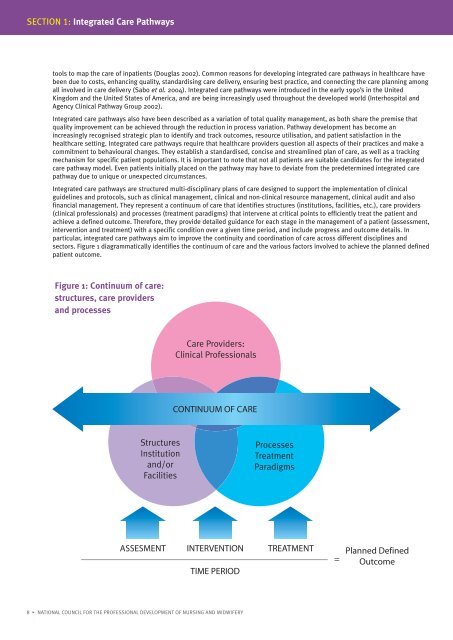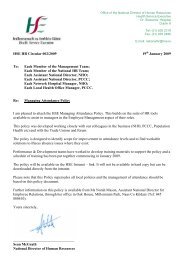Integrated Care Pathways - PNA
Integrated Care Pathways - PNA
Integrated Care Pathways - PNA
- No tags were found...
You also want an ePaper? Increase the reach of your titles
YUMPU automatically turns print PDFs into web optimized ePapers that Google loves.
SECTION 1: <strong>Integrated</strong> <strong>Care</strong> <strong>Pathways</strong>tools to map the care of inpatients (Douglas 2002). Common reasons for developing integrated care pathways in healthcare havebeen due to costs, enhancing quality, standardising care delivery, ensuring best practice, and connecting the care planning amongall involved in care delivery (Sabo et al. 2004). <strong>Integrated</strong> care pathways were introduced in the early 1990’s in the UnitedKingdom and the United States of America, and are being increasingly used throughout the developed world (Interhospital andAgency Clinical Pathway Group 2002).<strong>Integrated</strong> care pathways also have been described as a variation of total quality management, as both share the premise thatquality improvement can be achieved through the reduction in process variation. Pathway development has become anincreasingly recognised strategic plan to identify and track outcomes, resource utilisation, and patient satisfaction in thehealthcare setting. <strong>Integrated</strong> care pathways require that healthcare providers question all aspects of their practices and make acommitment to behavioural changes. They establish a standardised, concise and streamlined plan of care, as well as a trackingmechanism for specific patient populations. It is important to note that not all patients are suitable candidates for the integratedcare pathway model. Even patients initially placed on the pathway may have to deviate from the predetermined integrated carepathway due to unique or unexpected circumstances.<strong>Integrated</strong> care pathways are structured multi-disciplinary plans of care designed to support the implementation of clinicalguidelines and protocols, such as clinical management, clinical and non-clinical resource management, clinical audit and alsofinancial management. They represent a continuum of care that identifies structures (institutions, facilities, etc.), care providers(clinical professionals) and processes (treatment paradigms) that intervene at critical points to efficiently treat the patient andachieve a defined outcome. Therefore, they provide detailed guidance for each stage in the management of a patient (assessment,intervention and treatment) with a specific condition over a given time period, and include progress and outcome details. Inparticular, integrated care pathways aim to improve the continuity and coordination of care across different disciplines andsectors. Figure 1 diagrammatically identifies the continuum of care and the various factors involved to achieve the planned definedpatient outcome.Figure 1: Continuum of care:structures, care providersand processes<strong>Care</strong> Providers:Clinical ProfessionalsCONTINUUM OF CAREStructuresInstitutionand/orFacilitiesProcessesTreatmentParadigmsASSESMENTINTERVENTIONTIME PERIODTREATMENT=Planned DefinedOutcome8 • NATIONAL COUNCIL FOR THE PROFESSIONAL DEVELOPMENT OF NURSING AND MIDWIFERY













